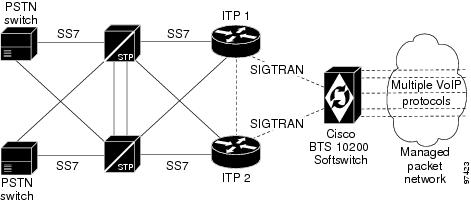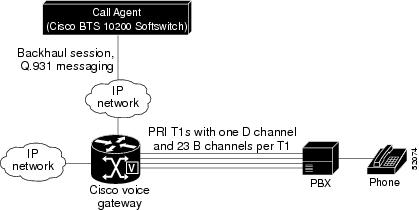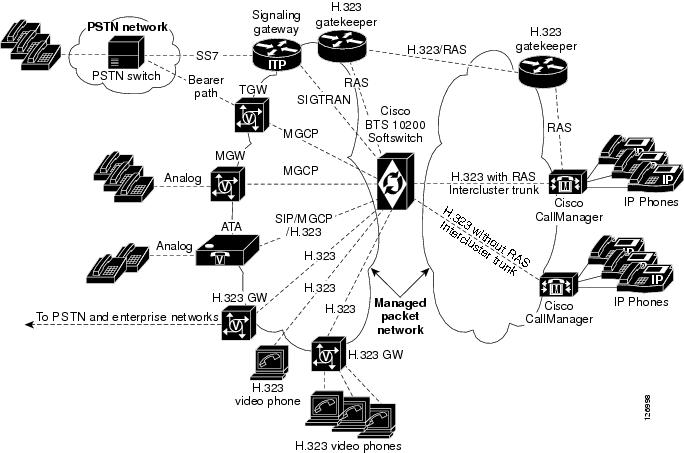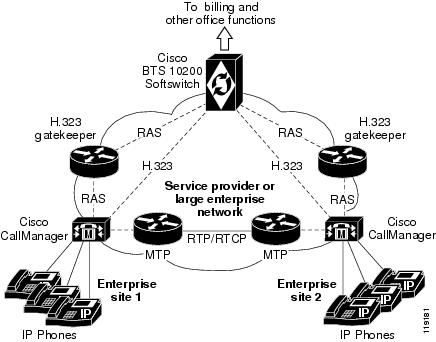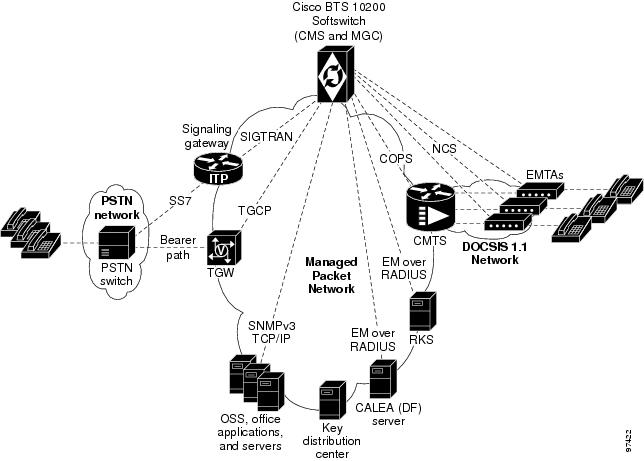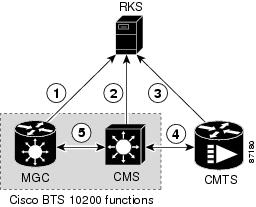

Table Of Contents
General Functions of the MGCP Interface
Special Functions of MGCP Interface
SS7 Signaling Support Through SIGTRAN
ISUP Transparency with the Cisco PGW 2200
Call Progress Signaling for SIP Subscriber on Call Hold
Cause Code Selection Precedence
Additional SIGTRAN and SS7 Information
SIP and SIP-T Signaling Support
PacketCable-Based Signaling Support
Supported Signaling Protocols
Revised: April 17, 2008, OL-7312-11The Cisco BTS 10200 Softswitch supports the following types of external signaling protocols:
•
Media Gateway Control Protocol (MGCP) line
•
MGCP Channel-Associated Signaling (CAS)
•
Integrated Services Digital Network (ISDN) primary rate interface (PRI)
•
Signaling Transport (SIGTRAN) for SS7 applications, including ISDN user part (ISUP) support for several national ISUP variants
•
H.323
•
Session Initiation Protocol (SIP) and SIP-T
•
PacketCable-based signaling protocols:
–
Network-Based Call Signaling (NCS) protocol
–
Trunking Gateway Control Protocol (TGCP)
–
DQoS/COPS query and response protocol
–
Remote authentication dial-in user service (RADIUS) authentication protocol (IETF RFC 2865)
The Cisco BTS 10200 Softswitch interworks with a wide range of network elements (NEs), but there are certain limitations. We recommend that you keep the following caution in mind as you prepare to purchase and use NEs for your network.
CautionSome signaling features involve the use of other NEs deployed in the service provider network, for example, gateways, media servers, announcement servers, eMTAs, H.323 endpoints, and SIP phones. See the "Component Interoperability" section of the Release Notes for a complete list of the specific peripheral platforms, functions, and software loads that have been used in system testing for interoperability with the Cisco BTS 10200 Softswitch Release 4.5.x software. Earlier or later releases of platform software might be interoperable and it might be possible to use other functions on these platforms. The list in the Release Notes certifies only that the required interoperation of these platforms, the functions listed, and the protocols listed have been successfully tested with the Cisco BTS 10200 Softswitch.
The signaling types are described in more detail in the sections that follow:
•
SS7 Signaling Support Through SIGTRAN
•
SIP and SIP-T Signaling Support
•
PacketCable-Based Signaling Support
MGCP Line Signaling Support
Media gateways (MGWs) provide bearer paths between voice and packet networks. MGWs also provide connection control, endpoint control, auditing, and status functions. These gateways are equipped with voice coders that convert voice into packets, and voice decoders that convert packets into voice. Connections are grouped in calls, which means that a call can have one or more connections. One or more Call Agents (CAs) set up the connections and calls.
The Cisco BTS 10200 Softswitch connects to a variety of MGWs using Media Gateway Control Protocol (MGCP), and provides voice over IP (VoIP) bearer-path control. This implementation is based upon the evolving industry standards for MGCP, including the following MGCP variants:
•
MGCP (IETF Version 0.1, Draft 5, February 1999)
•
MGCP (IETF RFC 2705, Version 1.0, October 1999)
Note
The MGCP-VERSION and MGCP-VARIANT parameters in the MGW-PROFILE table are used to identify the MGCP version and variant that an MGW supports.
General Functions of the MGCP Interface
The MGCP interface performs the following functions:
•
Handles MGW initialization
•
Provides endpoint auditing
•
Provides MGW fault management
•
Provides maintenance and administration of each termination, MGW operational states, and so forth
•
Carries call-control signaling
•
Carries media-path control signaling
Special Functions of MGCP Interface
The Cisco BTS 10200 Softswitch supports several special-purpose MGCP-based functions:
•
Codec selection service—The process a CA uses to find a common codec (coder/decoder) type between an originating and terminating call leg so a call can go through. The preferred codec type for originating and terminating calls is provisioned by the service provider using the QoS table in the Cisco BTS 10200 Softswitch database. The QoS can be configured for a subscriber or trunk group (TG). The CA makes a decision on actual codec type based on a combination of the following conditions:
–
Codec types available on the MGW—The MGW dynamic profile (list of supported codecs reported by MGW) or MGW static codec list (list of supported codecs configured in the Cisco BTS 10200 Softswitch).
–
The codec type provisioned in the QoS table—If a certain codec type is provisioned in the QoS table but not available in the MGW dynamic profile or TG profile, that type cannot be used. When no matching code is found, default pulse code modulation mu-law (PCMU) codec is used.
The following codec types are supported:
–
G.711 mu-law (PCMU)—Default value for codec type
–
G.711 A-law (PCMA)
–
G.723.1 High rate
–
G.723.1 Annex A High rate
–
G.723.1 Low rate
–
G.723.1 Annex A Low rate
–
G.729
–
G.729 Annex B
–
G.726 32K rate
–
G.726 24K rate
–
G.726 16K rate
–
G.728
•
Resource Reservation Protocol (RSVP)—An Internet Engineering Task Force (IETF) protocol for providing integrated services and reserving resources on the IP network. The service provider provisions the preferred reservation profile (guaranteed, controlled load, or best effort) in the QoS table. When a reservation is needed on a connection, the Cisco BTS 10200 Softswitch specifies the preferred reservation profile to the gateway. Whether or not RSVP is used depends on the configuration of the gateway as well as the preferred reservation profile specified by the Cisco BTS 10200 Softswitch. If the best-effort RSVP profile is specified, RSVP is not performed.
•
Announcement server—A media server that stores network-based announcements and plays them to a caller upon request from the Cisco BTS 10200 Softswitch. The announcement server interfaces with the Cisco BTS 10200 Softswitch using MGCP. Every Cisco BTS 10200 Softswitch in the network requires its own announcement server.
•
Dual tone multifrequency (DTMF) signaling—Signaling that is transported across the IP network under MGCP control.
•
Channel-Associated Signaling (CAS)—Signaling that is used with the MGCP interworking function.
•
Voice over ATM (VoATM) support—Configurable parameters that support ATM extensions (AAL1, AAL2, and AAL5) on MGCP.
Note
The ATM adaptation layer (AAL) is a standards-based layer that allows multiple applications to have data converted to and from an ATM cell. It uses a protocol that translates data for higher-layer services into the size and format of an ATM cell.
MGCP CAS Signaling Support
The Cisco BTS 10200 Softswitch supports the following MGCP CAS interfaces:
•
Public safety answering point (PSAP) systems interface for 911 emergency services
•
Operator services interface, including a legacy operator services interface that uses MF/T1 trunks
•
PBX interfaces
Note
CAS is used with the MGCP interworking function.
SS7 Signaling Support Through SIGTRAN
The Cisco BTS 10200 Softswitch communicates with Signaling System 7 (SS7)-based PSTN switches and service control points (SCPs) by using a SIGTRAN-based signaling gateway (SG). The SIGTRAN interface carries all SS7 messages encapsulated in IP packets. The Cisco IP Transfer Point (ITP) is one of the SGs used with the Cisco BTS 10200 Softswitch for this purpose.
Interface to the SS7 Network
The basic interface of the Cisco BTS 10200 Softswitch to the SS7 network is shown in Figure 2-1.
Figure 2-1 Cisco BTS 10200 Softswitch Interface to the SS7 Network
Note
For information on compatibility with specific Cisco ITPs, see the "Cisco ITP Signaling Gateways" section in the Cisco BTS 10200 Softswitch Release Notes.
The Cisco BTS 10200 Softswitch can be configured to have multiple originating point codes (OPCs). For information on OPCs, network configuration options, and subsystems, see the Cisco BTS 10200 Softswitch SS7 SIGTRAN Solution Guide.
For additional information, see the following standards and industry documents:
•
ANSI T1.113, Telecommunications Signaling System No. 7 (SS7)-Integrated Services Digital Network (ISDN) User Part (ISUP)
•
GR-317-CORE, Switching System Requirements for Call Control Using the Integrated Services Digital Network User Part
•
GR-394-CORE, Switching System Generic Requirements for Interexchange Carrier Interconnection Using the Integrated Services Digital Network User Part
•
GR-533-CORE, LSSGR: Database Services Service Switching Points-Toll-Free Service
•
GR-1188-CORE, LSSGR: CLASS Feature: Calling Name Delivery Generic Requirements
•
IETF RFC 2960, Stream Control Transport Protocol (SCTP)
•
IETF draft-ietf-sigtran-sua-14.txt, Signalling Connection Control Part User Adaptation Layer (SUA)
Support for ISUP Variants
The Cisco BTS 10200 Softswitch supports the following ISUP variants:
•
ANSI ISUP (for NANP region, based on Telcordia document GR-317)—Release 3.5 and later
•
ITU93 White Book ISUP—Release 4.2 and later
•
European Telecommunications Standards Institute (ETSI) v2 ISUP—Release 4.4.1 and later
•
Q.761 Standard—Release 4.1 and later
•
Q.761 China—Release 4.1 and later
•
Q.761 Thailand—Release 4.2 and later
•
Q.761 ETSI v3 Hungary—Release 4.5.x and later
•
Q.761 Standard 97—Release 4.5.1 and later
•
Q.761 ETSI v3 France—Release 4.5.1 and later
•
Q.761 ETSI v3 Poland—Release 4.5.1 and later
•
Q.767 Standard—Release 4.1 and later
•
Q.767 Mexico—Release 4.1 and later
•
Q.767 Colombia—Release 4.5.1, Maintenance Release 2 and later
ISUP Transparency with the Cisco PGW 2200
ISUP transparency provides the capability for the Cisco BTS 10200 Softswitch to transfer Generic Transparency Descriptor (GTD) messages and information elements across an IP network to a Cisco PGW 2200. In the Cisco PGW 2200, the GTD messages are mapped to ISUP messages, repackaged, and sent out to the PSTN/SS7 network. ISUP transparency is important because it enables the transport of calls from a Session Initiation Protocol (SIP) network through an IP network and out to a PSTN network without any loss of signaling information. ISUP transparency is achieved with the use of the Cisco GTD mechanism. GTD provides a means to specify messages of various protocols used in the PSTN network in plain text format. In that format, they can be easily understood by the network elements (NEs) within the IP network or on the boundary between the PSTN and IP networks.
Note
This feature is supported in Cisco PGW Software Release 9.6(1) and Cisco BTS 10200 Softswitch Software Release 4.5.x.
The ISUP transparency function on the BTS-PGW interface, illustrated in Figure 2-2, passes normalized parameters to expedite (1) mapping at the PSTN interconnect side and (2) any feature invocation necessary on either the Cisco PGW 2200 or the Cisco BTS 10200 Softswitch. It adds support for GTD attachments to SIP-T trunk messages, allowing the Cisco BTS 10200 Softswitch to interwork with the Cisco PGW 2200 for interconnection to the PSTN.
Figure 2-2
ISUP Transparency on the BTS-PGW Interface
When the Cisco BTS 10200 Softswitch generates SIP messages to be sent out on SIP-T trunks, a GTD attachment is generated based on the GTD parameters defined in the GTD-PARMS token in the Softswitch Trunk Group Profile (softsw-tg-profile) table. The Cisco PGW 2200 decodes GTD attachments of incoming SIP messages, and converts all GTD parameter contents to the equivalent ISUP values in the appropriate information element on the outgoing PSTN side.
When the egress trunk is a SIP-T trunk, the system supports the mapping of Progress Indication messages from the Cisco BTS 10200 Softswitch to SIP INFO messages with GTD attachments containing Call Progress (CPG) messages. This supported feature applies only to SIP subscribers. When a SIP INFO or RE-INVITE message is received over a SIP-T trunk with a GTD attachment containing a CPG message, a Progress Indication message is generated and sent to the system.
In the deployment model, the Cisco PGW 2200 is the PSTN gateway, and the Cisco BTS 10200 Softswitch provides a residential or Centrex application platform.
PSTN Supplementary Services
The following PSTN supplementary services are enabled by the ISUP transparency feature:
•
Number ID supplementary services
–
Direct Dial In (DDI)
–
Calling Line Identification Presentation (CLIP)
–
Calling Line Identification Restriction (CLIR)
•
Call diversion supplementary services
–
Call Forwarding Busy (CFB)
–
Call Forwarding No Reply (CFNR)
–
Call Forwarding Unconditional (CFU)
–
Call Waiting (CW)
–
Call Hold (HOLD)
•
Multiparty supplementary services
–
Three-Party Service (3PTY)
•
Transparency requirements
–
Ability to provision which parameters to transport over GTD
–
Call Forwarding No Answer (CFNA)
–
Call Waiting (CW)
–
Call Transfer (SIP Refer is not supported with SIP subscriber Hold signaling)
–
Ability to correlate billing records
•
Functionality provided by the Cisco PGW 2200
–
Number Portability (NP)
–
NoA relay
–
Information/Information Request (INF/INR) and Identification Request/Identification Response (IDR/IDS) messaging
–
ITU Method 2 circuit selection
–
NoA modification and routing
–
Calling Party Category (CPC) based routing
–
Ability to modify A-number based on B-number and B-number based on A-number
–
Cause analysis
–
Redirecting A-number screening
–
Virtual VPN behavior
–
Calling Party Number (CGPN) Address Presentation Indicators
Call Progress Signaling for SIP Subscriber on Call Hold
The Cisco BTS 10200 Softswitch can be provisioned to send a call-hold event signal to the other party in the call when a SIP subscriber goes on or off hold. This provisioning is done by means of the SIP-SUB-SEND-CPG-ON-HOLD-SIGNAL token in the CA-CONFIG table. The default value of this token is N. Therefore, you must change this value to Y if you want this signal to be sent for all SIP subscribers.
Note
The message sent to mute the media path is always sent to the other party, regardless of this flag setting.
Limitations
This feature is subject to the following limitations:
•
SIP Refer is not supported with SIP Subscriber Send CPG on Hold Signaling.
•
Overdecadic digits are not supported.
•
The Cisco PGW 2200 does not send INR messages to the Cisco BTS 10200 Softswitch. It responds to INR requests with an INF indication that there is no new information.
GTD Parameters Supported
Table 2-1 shows the GTD parameters supported by this feature and indicates the GTD messages in which each parameter is supported. The values in the GTD Parameter and Name columns of this table are placed in the static Generic Transparency Descriptor Parameter Values (gtd-parm-values) table. You select values from the GTD Parameter column to provision the GTD-PARMS token in the Softswitch Trunk Group Profile (softsw-tg-profile) table.
Enabling a parameter causes it to be encoded in an outgoing GTD attachment of a SIP message on the trunk group if the information is available in the call context.
Only the GTD parameter listed for each GTD message type is decoded when a SIP message with a GTD attachment is received by the system from the network.
For example, the GTD ACL parameter in a GTD REL message will be decoded if it is received, whether it is provisioned or not. However, a GTD UUS parameter received in a GTD REL message is ignored, even if it is provisioned, because it is not in the table.
Note
Columns in Table 2-1 show the GTD message in which each GTD parameter is supported. This information is for reference only and is not provisionable.
Note
UID is only decoded. It is never encoded.
Billing Fields
The BTS 10200 and PGW 2200 produce their own independent billing records. Downstream billing mediation servers use the SIP Call ID to correlate the two records, if required. The SIP Call ID is available in the PGW 2200 CDR record, tag 4203, and in the BTS 10200 CDR record, fields 116 and 144.
Cause Code Selection Precedence
The system performs cause code selection according to the following order of precedence:
1.
SIP header reason code
2.
GTD body
3.
SIP response code
Troubleshooting
There are no troubleshooting tools created specifically for the transparency feature. Use the existing tools to extract traces from log files on the BTS 10200 and the call trace and siptool capabilities on the PGW 2200. Both tools support ASCII attachments such as the GTD attachment.
Provisioning Procedure
See the "ISUP Transparency on the BTS-PGW Interface" section in the Cisco BTS 10200 Softswitch Provisioning Guide.
Additional SIGTRAN and SS7 Information
For additional information on provisioning and using SIGTRAN and SS7 protocols on the Cisco BTS 10200 Softswitch, see the SIGTRAN Solution Guide.
ISDN Signaling Support
This section describes the Integrated Services Digital Network (ISDN) Primary Rate Interface (PRI) variants and supplementary services supported by the Cisco BTS 10200 Softswitch. ISDN PRI allows the Cisco BTS 10200 Softswitch to interconnect to small and medium businesses using legacy PBX PRI interfaces. The basic ISDN NEs and signaling connections are shown in Figure 2-3.
Note
Standby elements in the figure are omitted for clarity.
Figure 2-3 Example of ISDN NEs
The design provides for transport of PRI information elements (IEs) and messages. Interoperability is supported with the following PRI variants:
•
Nortel DMS-100
•
AT&T 4ESS
•
Lucent 5ESS
•
NI2
The Cisco BTS 10200 Softswitch supports the following capabilities:
•
ISDN T1 PRI
•
Q.921 and Q.931 network side
•
ISDN backhaul communication of Q.931 messages from MGWs to the Cisco BTS 10200 Softswitch
•
Facility Associated Signaling (FAS)
•
Non-Facility Associated Signaling (NFAS)
•
Backup D channel
Note
For additional details and procedures for the Cisco BTS 10200 Softswitch ISDN implementation, see the Cisco BTS 10200 Softswitch ISDN Provisioning and Troubleshooting Guide.
H.323 Signaling Support
Note
H.323 applications are supported in Release 4.5.1 but not in Release 4.5.0.
The Cisco BTS 10200 Softswitch functions as a logical H.323 gateway to communicate with H.323 gatekeepers (GKs), and with Cisco CallManager and other H.323 gateways. The Cisco BTS 10200 Softswitch also provides signaling for other trunks and lines over MGCP and SIP protocols. In addition, it communicates with signaling gateways (SGs) for SS7 signaling and with trunking gateways (TGWs) that provide the bearer path to the PSTN. This allows H.323 Internet VoIP traffic to be carried seamlessly into the PSTN networks.
These signaling links are shown in Figure 2-4.
Note
You can configure up to four logical H.323 gateways on the Cisco BTS 10200 Softswitch.
Figure 2-4 Signaling Links between Cisco BTS 10200 Softswitch, Cisco CallManager, and Other Service Provider NEs
The interoperability between the Cisco BTS 10200 Softswitch, Cisco CallManager, and Cisco IOS H.323 gateways enhances the delivery of call control features between enterprise networks and service provider networks. These systems interoperate to provide subscriber features such as call forwarding, call waiting, call transfer, and three-way calling. The Cisco BTS 10200 Softswitch can be used to connect calls between two phones that reside on different Cisco CallManager systems (see Figure 2-5). Signaling of certain information, for example connected name and number information, is transparently passed from the terminating Cisco CallManager to the Cisco BTS 10200 Softswitch and back to the originating Cisco CallManager.
Figure 2-5 Example of Connecting Calls from Phones on Separate Cisco CallManager Systems
Note
For additional technical discussion, prerequisites, and provisioning steps, see the Cisco BTS 10200 Softswitch H.323 Provisioning and Troubleshooting Guide.
SIP and SIP-T Signaling Support
The Cisco BTS 10200 Softswitch uses Session Initiation Protocol (SIP) and SIP for telephones (SIP-T) signaling to communicate with other SIP-based NEs. This implementation is based upon the evolving industry standards for SIP, including IETF document RFC 3261, SIP: Session Initiation Protocol.
Note
This section provides an overview of SIP implementation on the Cisco BTS 10200 Softswitch. For SIP feature details and applicable procedures, see the Cisco BTS 10200 Softswitch SIP Protocol User Guide and the Cisco BTS 10200 Softswitch SIP Protocol Provisioning Guide.
SIP Functions
The Cisco BTS 10200 Softswitch supports both SIP trunks and SIP-based subscriber lines (SIP phones). It provides the following SIP-related functions:
•
Protocol conversion between SIP and several other protocols, including SS7, PRI, H.323, MGCP, and CAS
•
Tandem back-to-back user agent (UA) for direct SIP-to-SIP calls (trunk to trunk, phone to phone, and trunk to/from phone), and SIP-to-SIP-T calls
Note
There is no provisioning associated with the back-to-back UA functionality. The Cisco BTS 10200 Softswitch automatically acts as a back-to-back UA when there is a SIP-to-SIP call.
•
SS7 bridging between softswitches by means of SIP-T methods
•
Native support of SIP endpoints such as SIP phones, including authentication and registration management. (For example, the Cisco BTS 10200 Softswitch maintains the current location of SIP subscribers.)
•
Verification of the SIP REGISTER message to ensure that it came from a provisioned endpoint
SIP roles performed by the Cisco BTS 10200 Softswitch include:
•
User agent server (UAS)
•
User agent client (UAC)
•
Registrar
Applicable SIP references are listed in the "SIP and SIP-T References" section.
SIP Features
The Cisco BTS 10200 Softswitch supports the following SIP features:
•
Reliable provisional response
•
3XX redirect response on SIP trunks
•
SIP hairpin
•
Third-party call control (3PCC)
•
ANI-based routing for SIP calls
•
DTMF relay for communications with interactive voice response (IVR) servers
–
SUBSCRIBE/NOTIFY method
–
INFO method
•
Message waiting indicator
•
Diversion header
•
UAC and UAS forking
•
SIP session timer
•
Type of service (ToS) for SIP signaling
•
DNS services (DNS SRV) lookup for initiating SIP calls
•
DNS naming authority pointer (NAPTR) lookup for initiating SIP calls
•
Mapping the carrier identification code (CIC) in the SIP uniform resource identifier (URI) to a transit network selection (TNS)
•
SIP register
•
SIP authentication
•
SIP refer
•
SIP trunk audit
•
SIP-trunk route advance with provisionable timer for Invite retransmission
SIP-T Support
The Cisco BTS 10200 Softswitch supports SIP-T functions. SIP-T is used to bridge calls between two SS7 networks. SIP-T encapsulates the SS7 ISUP information elements (based on GR-317 ISUP version) and carries them through the packet network. It provides for encapsulation/decapsulation at the PSTN gateways and helps route the call through the packet network. SIP-T functions are described in IETF RFC 3398, Integrated Services Digital Network (ISDN) User Part (ISUP) to Session Initiation Protocol (SIP) Mapping.
FCP Interface
The Cisco BTS 10200 Softswitch uses Feature Control Protocol (FCP) for internal communications between the Call Agent (CA) and Feature Server (FS) components. FCP is a Multipurpose Internet Mail Extension (MIME) application on top of SIP. FCP uses SIP for transport, and carries call state control and status information needed for feature control.
SIP Billing Support
The Cisco BTS 10200 Softswitch provides call data for billing on SIP calls. Specific fields are supported in the call detail records for calls that originate or terminate on a SIP trunk or subscriber line. For detailed information on billing management and data, see the Cisco BTS 10200 Softswitch Billing Interface Guide.
SIP and SIP-T References
The BTS 10200 SIP implementation is based on the evolving standards in the Internet Engineering Task Force (IETF) Request for Comments (RFC) publications, including the documents in the following list, and may not be fully compliant in all cases. The BTS 10200 is largely compliant with RFC 3261. For the level of compliance with all other RFC publications and drafts referenced below, see the specific feature descriptions.
•
RFC 2617, HTTP Authentication
•
RFC 2976, SIP INFO method
•
RFC 3261, SIP: Session Initiation Protocol
•
RFC 3262, Reliability of Provisional Responses in the Session Initiation Protocol (SIP)
•
RFC 3263, Session Initiation Protocol (SIP): Locating SIP Servers
•
RFC 3265, Session Initiation Protocol (SIP)-Specific Event Notification
•
RFC 3311, The Session Initiation Protocol (SIP) UPDATE Method
•
RFC 3372, Session Initiation Protocol for Telephones (SIP-T): Context and Architectures
•
RFC 3398, Integrated Services Digital Network (ISDN) User Part (ISUP) to Session Initiation Protocol (SIP) Mapping
PacketCable-Based Signaling Support
This section summarizes Cisco BTS 10200 Softswitch support for PacketCable-based signaling and includes the following topics:
PacketCable-Based Functions
In a PacketCable-based network, the Cisco BTS 10200 Softswitch functions as both a call management server (CMS) and a media gateway controller (MGC).
The Cisco BTS 10200 Softswitch provides call control, call routing, and signaling for several types of NEs:
•
Multimedia terminal adapters (MTAs) and embedded MTAs (eMTAs)
•
Cable modem termination systems (CMTSs)
•
Trunking gateways (TGWs)
The Cisco BTS 10200 Softswitch supports cable access for voice application, including communications with the Cisco UBR 7246 and Cisco UBR 924 universal broadband routers. It also provides interfaces to Record Keeping Servers (RKSs) for billing purposes, and IP security functions.
The Cisco BTS 10200 Softswitch provides support for the following PacketCable-based protocols and functions:
•
Network-Based Call Signaling (NCS) protocol.
•
Trunking Gateway Control Protocol (TGCP).
Note
NCS protocol and TGCP are based on MGCP; they are referred to as profiles of MGCP.
•
Dynamic Quality of Service (DQoS)/Common Open Policy Service (COPS) query and response protocol.
•
RADIUS authentication protocol (IETF RFC 2865), used for transmission of event messages (EMs) to an external RKS for billing purposes.
•
Security features, including implementation of IP security (IPsec) architecture, key management using Internet Key Exchange (IKE) and Kerberos, and encryption of certain IPsec keys.
•
Interface for support of lawful intercept and the Communications Assistance for Law Enforcement Act (CALEA). See the "Lawful Intercept Interface" section in the Cisco BTS 10200 Softswitch Network and Subscriber Feature Descriptions document for a description of this feature.
Note
For detailed information on compliance with specific paragraphs of the IETF standards (for TGCP, IP Security, NCS, and so forth), contact your Cisco account team.
Figure 2-6 shows a typical network with PacketCable-based NEs and the applicable external interfaces of the Cisco BTS 10200 Softswitch.
Figure 2-6 Example of PacketCable-Based Network Architecture
Event Message Implementation
This section describes the implementation of the event message (EM) feature on the Cisco BTS 10200 Softswitch. EMs are real-time call data records containing information about network usage and activities. They are typically used for billing purposes in a PacketCable-based network. The Cisco BTS 10200 Softswitch (which performs the CMS and MGC functions) transfers EMs to an external RKS that assembles call detail records (CDRs) from the EMs.
Note
Event messages are also transmitted over RADIUS from the Cisco BTS 10200 Softswitch to a CALEA interface, with IPsec for encryption and authentication, and IKE for key management.
Figure 2-7 illustrates the PacketCable NEs and interfaces involved in the generation and processing of EMs.
Figure 2-7 Event Message Interfaces
Notes for Figure 2-71.
MGC to RKS—EMs generated by the MGC function in the Cisco BTS 10200 Softswitch are sent to the RKS.
2.
CMS to RKS—EMs generated by the CMS function in the Cisco BTS 10200 Softswitch are sent to the RKS.
3.
CMTS to RKS—EMs generated by the CMTS are sent to the RKS. The Cisco BTS 10200 Softswitch (MGC/CMS) is not involved.
4.
CMS to CMTS—The CMS function in the Cisco BTS 10200 Softswitch sends the Billing Correlation ID (BCID) to the CMTS using the DQoS GateSet message.
5.
CMS to MGC—There is an internal exchange of originating/terminating information such as BCID and FEID.
Note
For additional technical discussion, prerequisites, and provisioning steps, see the Cisco BTS 10200 Softswitch PacketCable Protocol Guide.
Security Implementation
The implementation of PKT-SP-SEC-I07-021127, PacketCable Security Specification, November 27, 2002, provides a security scheme for the voice-over-cable network based on a set of security protocols. These protocols, described in the documents listed below, provide authentication (to help prevent theft of bandwidth, denial-of-service attack, replay, and so forth) and enable message integrity, privacy, and confidentiality.
•
IETF documents covering IPsec architecture:
–
RFC 2401, Security Architecture for the Internet Protocol, November 1998
–
RFC 2406, IP Encapsulating Security Payload (ESP), November 1998
•
IETF documents covering key management protocols IKE and Kerberos with extensions:
–
RFC 2409, The Internet Key Exchange (IKE), November 1998
–
RFC 1510, The Kerberos Network Authentication Service (V5), September 1993, with updates presented in PKT-SP-SEC-I06-021018
The Cisco BTS 10200 Softswitch performs the security functions of the CMS and MGC in the PacketCable environment. It supports security in accordance with PKT-SP-SEC-I07-021127 for both signaling and media:
•
Signaling security—For signaling from CMS to eMTA, CMS to CMTS, and MGC to TGW
•
Media (bearer) security—For signaling between originating eMTA and terminating eMTA, which is facilitated by the CMS during call signaling setup.
A special parameter, IPSEC_ENABLED, must be set in the opticall configuration file (opticall.cfg) at the time of software installation to enable the IPsec feature. The IPSEC_ENABLED value cannot be changed by use of CLI commands.
Note
The value of the IPSEC_ENABLED parameter and all other opticall.cfg parameters for your installation are listed in the Network Information Data Sheet that Cisco provided with your system.

 Feedback
Feedback

